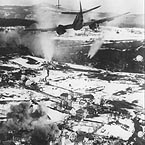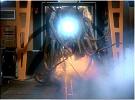DBS
Posts: 513
Joined: 4/29/2004
Status: offline

|
Have now started looking at German figures. Interesting... definition of "effective ceiling" may be part of the problem. Westermann's "Flak" seems to suggest that the German definition was more along the lines of ballistically accurate fire - ie, when does loss of velocity, atmospherics, etc, start screwing up predictability of where the round will go, rather than meaningful engagement of target. Interestingly, the 88mm Flak 18 is normally quoted as having an effective ceiling of 26,000. Yet in Feb 1939, a German study of the Flak defences for the Reich, especially along the French frontier, assumed that an anti-aircraft belt based around the Flak 18 would force enemy aircraft to climb to between 19,500 and 26,000 feet. The inference would seem to be that they would only be truly safe at 26,000, but that they would be reasonably safe at 19,500 or more. This performance was nevertheless seen as well worth it, given that RAF pre-war doctrine assumed typical bombing heights of 10,000, and the Germans assumed that the increased altitude would degrade bombing accuracy and altitude stress the crews, even if they subsequently descended once clear of the belt.
The closest reference that I could find to the British 1936 definition was a German study of 1942, examining future performance requirements, that assessed the engagement window of existing heavy flak against a target at 29,500 feet; speed of target undefined, but presumably at heavy bomber speeds of say 200-250mph. The 88mm Flak 18 and 36 were judged to have a window of only 14 seconds, the 105mm to have 49 seconds, the 88mm Flak 41 and the 128mm to enjoy 68 seconds. At 36,000 feet (the Germans were worried about possible pressurised next generation aircraft), the 88/41 and 128 were judged to still have a window of 31 seconds.
The current 37mm height of 16,000 may not be too wild; in April 1941, Bomber Command judged a bombing height of 16,000 feet as desirable because of the threat of the 37mm, but it would seem fair to say that 12,000-16,000 was judged as the upper end of the 37mm threat window. The requirement for the 55mm flak was an effective ceiling of 15,000.
One real difficulty for BTR to model is the doctrinal limits often put on flak after the introduction of Herrmann's Wild Boars - eg in Jan 44 no flak engagement above 16,500 feet during night raids on Berlin, to allow the fighters free rein. Similar limits had previously been imposed over the Ruhr. This was linked with the discreditation of the flak as an effective defence; a bit unfair, but perhaps driven by German love of statistics. The fighters seemed to offer a better return, but of course it was easily forgotten that their effectiveness was linked to the AA searchlights. And by effectively banning flak engagement in such instances, the "poor" performance became a self-fulfilling prophecy.
Westermann makes the point that the 128mm batteries were regarded as elite and remained all-regular, unlike the other batteries diluted with volunteer and not-so-volunteer helpers.
Anyway, will post performance figures once I have done a little more digging, but from memory those in the game - at least post JCL mods - are pretty in accord with Ian Hogg's. As I said above, it may come down to different definitions of effective ceiling. In one book, Hogg points out that if one is being absolutely pedantic, there are three ceilings for any AA gun - maximum (absolute max to which the charge can throw the shell, without regard to any accuracy or fusing issues), effective (defined by accuracy and fuse time-out limits) and practical (the one at which one can actually engage a target for long enough to have a sensible chance of hitting); in more general usage he uses the term "effective" to mean "practical" at least for the British guns - thus the figures given at the start of this thread.
< Message edited by DBS -- 11/16/2005 5:33:07 PM >
|
 Printable Version
Printable Version
















 New Messages
New Messages No New Messages
No New Messages Hot Topic w/ New Messages
Hot Topic w/ New Messages Hot Topic w/o New Messages
Hot Topic w/o New Messages Locked w/ New Messages
Locked w/ New Messages Locked w/o New Messages
Locked w/o New Messages Post New Thread
Post New Thread